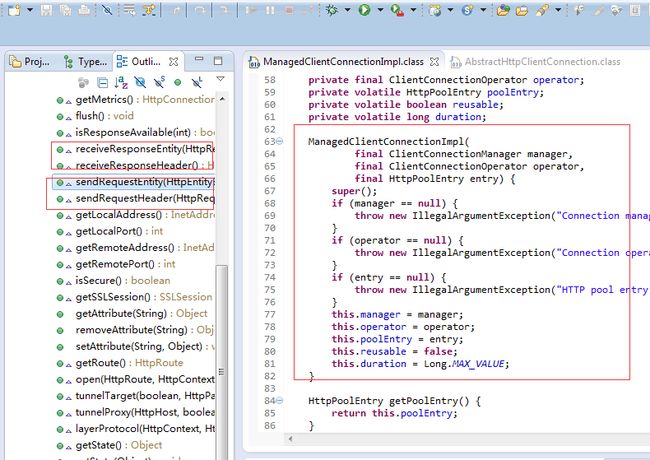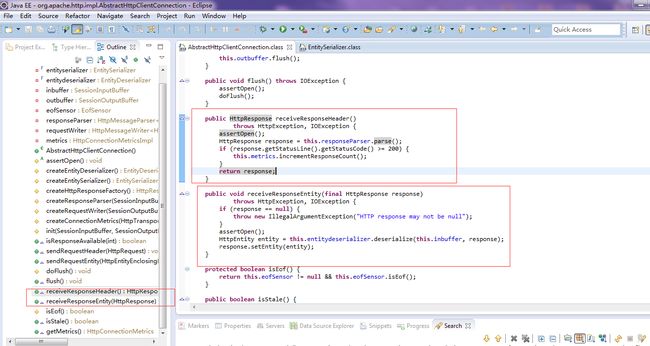Httpclient的传递依赖

连接复用策略
public interface ConnectionReuseStrategy {
/**
* Decides whether a connection can be kept open after a request.
* If this method returns <code>false</code>, the caller MUST
* close the connection to correctly comply with the HTTP protocol.
* If it returns <code>true</code>, the caller SHOULD attempt to
* keep the connection open for reuse with another request.
* <br/>
* One can use the HTTP context to retrieve additional objects that
* may be relevant for the keep-alive strategy: the actual HTTP
* connection, the original HTTP request, target host if known,
* number of times the connection has been reused already and so on.
* <br/>
* If the connection is already closed, <code>false</code> is returned.
* The stale connection check MUST NOT be triggered by a
* connection reuse strategy.
*
* @param response
* The last response received over that connection.
* @param context the context in which the connection is being
* used.
*
* @return <code>true</code> if the connection is allowed to be reused, or
* <code>false</code> if it MUST NOT be reused
*/
boolean keepAlive(HttpResponse response, HttpContext context);
}
---------------
public class DefaultConnectionReuseStrategy implements ConnectionReuseStrategy {
..........
if (hit.hasNext()) {
try {
TokenIterator ti = createTokenIterator(hit);
boolean keepalive = false;
while (ti.hasNext()) {
final String token = ti.nextToken();
if (HTTP.CONN_CLOSE.equalsIgnoreCase(token)) {
return false;
} else if (HTTP.CONN_KEEP_ALIVE.equalsIgnoreCase(token)) {
// continue the loop, there may be a "close" afterwards
keepalive = true;
}
}
if (keepalive)
return true;
// neither "close" nor "keep-alive", use default policy
} catch (ParseException px) {
// invalid connection header means no persistent connection
// we don't have logging in HttpCore, so the exception is lost
return false;
}
}
// default since HTTP/1.1 is persistent, before it was non-persistent
return !ver.lessEquals(HttpVersion.HTTP_1_0);
}
在复用Http连接的基础上,还要设置idleTime
// The connection is in or can be brought to a re-usable state.
reuse = reuseStrategy.keepAlive(response, context);
if (reuse) {
// Set the idle duration of this connection
long duration = keepAliveStrategy.getKeepAliveDuration(response, context);
if (this.log.isDebugEnabled()) {
String s;
if (duration > 0) {
s = "for " + duration + " " + TimeUnit.MILLISECONDS;
} else {
s = "indefinitely";
}
this.log.debug("Connection can be kept alive " + s);
}
managedConn.setIdleDuration(duration, TimeUnit.MILLISECONDS);
}
设置了超时后,可复用的链接在从池中取出来后,DefaultRequestDirector会检查此连接是否已经超时,如果超时,则关闭之.
为什么要关闭呢?我的理解是:
在此超时连接从被打开到关闭这段时间范围内,此连接可能已经被server所关闭(资源管理),此种场景下,此连接将无法被复用,故关闭之,requestDirector必须重新打开连接,才能继续后续的HTTP请求
function execute(){
.............
if (HttpConnectionParams.isStaleCheckingEnabled(params)) {
// validate connection
if (managedConn.isOpen()) {
this.log.debug("Stale connection check");
if (managedConn.isStale()) {
this.log.debug("Stale connection detected");
managedConn.close();
}
}
}
.........
}
---------------------------------------
DefaultRequestDirector 负责direct请求的执行,包含以下内容:
通过connManager获取连接
--> send request(headers,body)
--> 失败重试
--> 解析response
--> 判断是否reues connection, 不可以reuse,关闭连接
DefaultRequestDirector.execute是一个比较重的对象,构造此对象需要传入很多参数,策略,interface-Impl-bean
/**
* @since 4.2
*/
public DefaultRequestDirector(
final Log log,
final HttpRequestExecutor requestExec,
final ClientConnectionManager conman,
final ConnectionReuseStrategy reustrat,
final ConnectionKeepAliveStrategy kastrat,
final HttpRoutePlanner rouplan,
final HttpProcessor httpProcessor,
final HttpRequestRetryHandler retryHandler,
final RedirectStrategy redirectStrategy,
final AuthenticationStrategy targetAuthStrategy,
final AuthenticationStrategy proxyAuthStrategy,
final UserTokenHandler userTokenHandler,
final HttpParams params) {
这个类定义了httpClient.execute的几乎全部流程,主要围绕:
1 连接管理,connection keep alive,polling
2 拼接request保温,write protocol,write heads, write body
3 解析response, decode,chunked
// non-javadoc, see interface ClientRequestDirector
public HttpResponse execute(HttpHost target, HttpRequest request,
HttpContext context)
throws HttpException, IOException {
// Populate the execution context
context.setAttribute(ExecutionContext.HTTP_TARGET_HOST, target);
context.setAttribute(ExecutionContext.HTTP_PROXY_HOST, proxy);
context.setAttribute(ExecutionContext.HTTP_CONNECTION, managedConn);
// Run request protocol interceptors
requestExec.preProcess(wrapper, httpProcessor, context);
response = tryExecute(roureq, context);
if (response == null) {
// Need to start over
continue;
}
// Run response protocol interceptors
response.setParams(params);
requestExec.postProcess(response, httpProcessor, context);
// The connection is in or can be brought to a re-usable state.
reuse = reuseStrategy.keepAlive(response, context);
if (reuse) {
// Set the idle duration of this connection
long duration = keepAliveStrategy.getKeepAliveDuration(response, context);
if (this.log.isDebugEnabled()) {
String s;
if (duration > 0) {
s = "for " + duration + " " + TimeUnit.MILLISECONDS;
} else {
s = "indefinitely";
}
this.log.debug("Connection can be kept alive " + s);
}
managedConn.setIdleDuration(duration, TimeUnit.MILLISECONDS);
}
}
httpClient每执行一次请求,都会构造一个新的RequestDirector对象,然连接会通过连接池加以复用
AbstractHttpClient:
public final HttpResponse execute(HttpHost target, HttpRequest request,
HttpContext context)
throws IOException, ClientProtocolException {
if (request == null) {
throw new IllegalArgumentException
("Request must not be null.");
}
// a null target may be acceptable, this depends on the route planner
// a null context is acceptable, default context created below
HttpContext execContext = null;
RequestDirector director = null;
HttpRoutePlanner routePlanner = null;
ConnectionBackoffStrategy connectionBackoffStrategy = null;
BackoffManager backoffManager = null;
// Initialize the request execution context making copies of
// all shared objects that are potentially threading unsafe.
synchronized (this) {
HttpContext defaultContext = createHttpContext();
if (context == null) {
execContext = defaultContext;
} else {
execContext = new DefaultedHttpContext(context, defaultContext);
}
// Create a director for this request
director = createClientRequestDirector(
getRequestExecutor(),
getConnectionManager(),
getConnectionReuseStrategy(),
getConnectionKeepAliveStrategy(),
getRoutePlanner(),
getProtocolProcessor(),
getHttpRequestRetryHandler(),
getRedirectStrategy(),
getTargetAuthenticationStrategy(),
getProxyAuthenticationStrategy(),
getUserTokenHandler(),
determineParams(request));
routePlanner = getRoutePlanner();
connectionBackoffStrategy = getConnectionBackoffStrategy();
backoffManager = getBackoffManager();
}
try {
if (connectionBackoffStrategy != null && backoffManager != null) {
HttpHost targetForRoute = (target != null) ? target
: (HttpHost) determineParams(request).getParameter(
ClientPNames.DEFAULT_HOST);
HttpRoute route = routePlanner.determineRoute(targetForRoute, request, execContext);
HttpResponse out;
try {
out = director.execute(target, request, execContext);
} catch (RuntimeException re) {
if (connectionBackoffStrategy.shouldBackoff(re)) {
backoffManager.backOff(route);
}
throw re;
} catch (Exception e) {
if (connectionBackoffStrategy.shouldBackoff(e)) {
backoffManager.backOff(route);
}
if (e instanceof HttpException) throw (HttpException)e;
if (e instanceof IOException) throw (IOException)e;
throw new UndeclaredThrowableException(e);
}
if (connectionBackoffStrategy.shouldBackoff(out)) {
backoffManager.backOff(route);
} else {
backoffManager.probe(route);
}
return out;
} else {
return director.execute(target, request, execContext);
}
} catch(HttpException httpException) {
throw new ClientProtocolException(httpException);
}
}
}
=================== 连接和池 =================================
http-client对连接的抽象和封装
socket --> HttpClientConnection(面向socket进行open-close-send-recive,) --> ManagedClientConnection(open,markReuseable,state,setIdleDuration)

HttpRequestExecutor 会调用HttpClientConnection的read&recive方法发送和接收请求

public class HttpRequestExecutor{
........................................................
public HttpResponse execute(
final HttpRequest request,
final HttpClientConnection conn,
final HttpContext context)
throws IOException, HttpException {
if (request == null) {
throw new IllegalArgumentException("HTTP request may not be null");
}
if (conn == null) {
throw new IllegalArgumentException("Client connection may not be null");
}
if (context == null) {
throw new IllegalArgumentException("HTTP context may not be null");
}
try {
HttpResponse response = doSendRequest(request, conn, context);
if (response == null) {
response = doReceiveResponse(request, conn, context);
}
return response;
} catch (IOException ex) {
closeConnection(conn);
throw ex;
} catch (HttpException ex) {
closeConnection(conn);
throw ex;
} catch (RuntimeException ex) {
closeConnection(conn);
throw ex;
}
}
protected HttpResponse doSendRequest(
final HttpRequest request,
final HttpClientConnection conn,
final HttpContext context)
throws IOException, HttpException {
if (request == null) {
throw new IllegalArgumentException("HTTP request may not be null");
}
if (conn == null) {
throw new IllegalArgumentException("HTTP connection may not be null");
}
if (context == null) {
throw new IllegalArgumentException("HTTP context may not be null");
}
HttpResponse response = null;
context.setAttribute(ExecutionContext.HTTP_CONNECTION, conn);
context.setAttribute(ExecutionContext.HTTP_REQ_SENT, Boolean.FALSE);
conn.sendRequestHeader(request);
if (request instanceof HttpEntityEnclosingRequest) {
// Check for expect-continue handshake. We have to flush the
// headers and wait for an 100-continue response to handle it.
// If we get a different response, we must not send the entity.
boolean sendentity = true;
final ProtocolVersion ver =
request.getRequestLine().getProtocolVersion();
if (((HttpEntityEnclosingRequest) request).expectContinue() &&
!ver.lessEquals(HttpVersion.HTTP_1_0)) {
conn.flush();
// As suggested by RFC 2616 section 8.2.3, we don't wait for a
// 100-continue response forever. On timeout, send the entity.
int tms = request.getParams().getIntParameter(
CoreProtocolPNames.WAIT_FOR_CONTINUE, 2000);
if (conn.isResponseAvailable(tms)) {
response = conn.receiveResponseHeader();
if (canResponseHaveBody(request, response)) {
conn.receiveResponseEntity(response);
}
int status = response.getStatusLine().getStatusCode();
if (status < 200) {
if (status != HttpStatus.SC_CONTINUE) {
throw new ProtocolException(
"Unexpected response: " + response.getStatusLine());
}
// discard 100-continue
response = null;
} else {
sendentity = false;
}
}
}
if (sendentity) {
conn.sendRequestEntity((HttpEntityEnclosingRequest) request);
}
}
conn.flush();
context.setAttribute(ExecutionContext.HTTP_REQ_SENT, Boolean.TRUE);
return response;
}
...............................................
}
AbstractHttpClientConnection - 面向socket实现读写
send

完整的分析write代码,并给出一个完整的request 报文
需要考虑如下内容:
1 write head line
2 write http headers
3 write entity
class AbstractHttpClientConnection{
..................
public void sendRequestHeader(final HttpRequest request)
throws HttpException, IOException {
if (request == null) {
throw new IllegalArgumentException("HTTP request may not be null");
}
assertOpen();
this.requestWriter.write(request);
this.metrics.incrementRequestCount();
}
.........}
class AbstractMessageWriter{
............
protected abstract void writeHeadLine(T message) throws IOException;
public void write(final T message) throws IOException, HttpException {
if (message == null) {
throw new IllegalArgumentException("HTTP message may not be null");
}
writeHeadLine(message); // 写head行,就是method uri version之类的信息
for (HeaderIterator it = message.headerIterator(); it.hasNext(); ) { // 写header
Header header = it.nextHeader();
this.sessionBuffer.writeLine
(lineFormatter.formatHeader(this.lineBuf, header));
}
this.lineBuf.clear();
this.sessionBuffer.writeLine(this.lineBuf);
}
...........
}
public interface RequestLine {
String getMethod();
ProtocolVersion getProtocolVersion();
String getUri();
}
class BasicLineFormatter{
protected void doFormatRequestLine(final CharArrayBuffer buffer,
final RequestLine reqline) {
final String method = reqline.getMethod();
final String uri = reqline.getUri();
// room for "GET /index.html HTTP/1.1"
int len = method.length() + 1 + uri.length() + 1 +
estimateProtocolVersionLen(reqline.getProtocolVersion());
buffer.ensureCapacity(len);
buffer.append(method);
buffer.append(' ');
buffer.append(uri);
buffer.append(' ');
appendProtocolVersion(buffer, reqline.getProtocolVersion());
}
public CharArrayBuffer appendProtocolVersion(final CharArrayBuffer buffer,
final ProtocolVersion version) {
if (version == null) {
throw new IllegalArgumentException
("Protocol version may not be null");
}
// can't use initBuffer, that would clear the argument!
CharArrayBuffer result = buffer;
final int len = estimateProtocolVersionLen(version);
if (result == null) {
result = new CharArrayBuffer(len);
} else {
result.ensureCapacity(len);
}
result.append(version.getProtocol());
result.append('/');
result.append(Integer.toString(version.getMajor()));
result.append('.');
result.append(Integer.toString(version.getMinor()));
return result;
}
}
// non-javadoc, see interface LineFormatter
public CharArrayBuffer formatHeader(CharArrayBuffer buffer,
Header header) {
if (header == null) {
throw new IllegalArgumentException
("Header may not be null");
}
CharArrayBuffer result = null;
if (header instanceof FormattedHeader) {
// If the header is backed by a buffer, re-use the buffer
result = ((FormattedHeader)header).getBuffer();
} else {
result = initBuffer(buffer);
doFormatHeader(result, header);
}
return result;
} // formatHeader
/**
* Actually formats a header.
* Called from {@link #formatHeader}.
*
* @param buffer the empty buffer into which to format,
* never <code>null</code>
* @param header the header to format, never <code>null</code>
*/
protected void doFormatHeader(final CharArrayBuffer buffer,
final Header header) {
final String name = header.getName();
final String value = header.getValue();
int len = name.length() + 2;
if (value != null) {
len += value.length();
}
buffer.ensureCapacity(len);
buffer.append(name);
buffer.append(": ");
if (value != null) {
buffer.append(value);
}
}
} // class BasicLineFormatter
receive

池:poolEntry,route,increase
=============================================================




